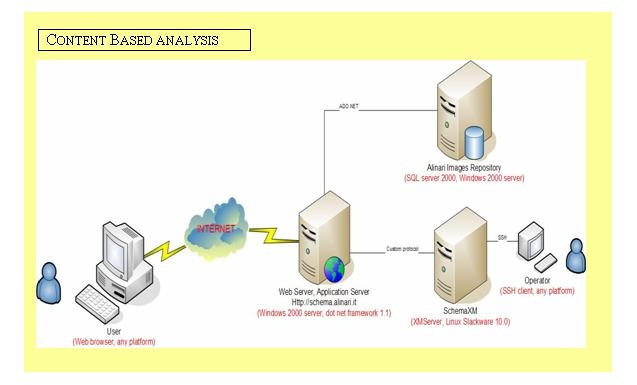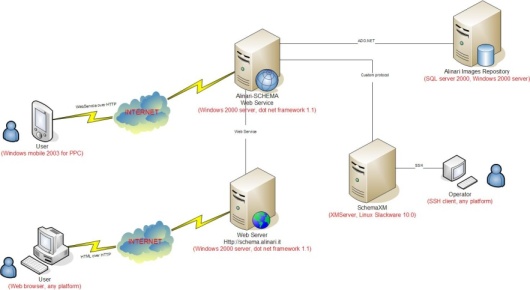D5.1orig-Appendix D - Content based analysis modules
| Warning: this is a copy of the D5.1 document as originally submitted to the EC.
To contribute please use: Appendix D - Content based analysis modules. |
Back to D5.1orig System Specification
Alinari Photo Archive R&D group has integrated an European funded CBR-engine (SCHEMA) into its architecture: the user can make queries in a textual way and use the "query by example" paradigm (uploading an image and searching visually similar images). Two different search systems have been connected: the Alinari Images Repository search engine performs textual query and the SCHEMA Reference System performs query by example and the results are then merged and optimized.
In order to process web requests, the Application server forwards the received query to the SCHEMA-XM Server and to the Images Repository Server and it visualizes the results of the query generating an HTML page. Notice that the web CBR system for the PDA is planned but is not yet developed.
The web services could be used simultaneously by different applications, regardless of the operating system they are running on and the programming language used for their development.
The mobile platform
The service was designed for the Windows Mobile-based PocketPC platform. Three main mobile platforms are available on the market:
- Symbian based devices (e.g. Nokia Communicator, Sony-Ericsson P910, Motorola A1000 etc.)
- Palm OS based devices (e.g. Treo 650, Palm Tungsten etc.)
- Windows Mobile-based platforms, of which there are two types:
- Windows Mobile-based PocketPC (e.g. HP iPaq, Orange SPV M2000 etc.)
- Windows Mobile-based Smartphones (e.g. Orange SPV C500, Motorola MPX220 etc.)
We have chosen the Windows Mobile-based PocketPC platform since the server side web service has been developed using Microsoft technologies. We preferred the PocketPC platform instead of the Smartphone platform since it uses the Wi-Fi connectivity in addition to the GPRS connectivity, with consequent advantages in terms of connection speed and costs.
Notice that the platform choice has to be considered only as one solution among several possibilities and in some respect is a result of the web-service choice made. Moreover, porting the application to a new platform is not a difficult task (typically the porting process takes more time to adapt the user interface than to change the underlying communication objects).
The application
The application starts with the search form. The user could perform a textual query or a query by example or a combined query. The user could also choose a sample photo browsing the Alinari-SCHEMA’s template repository to perform a query by example, the interface developed to be familiar to the PocketPC users.
The user should be enabled to browse the results generated by the Alinari-SCHEMA web service. He/she could use the search result to refine the search and view the annotation of each images and lastly save the image on his/her handheld .
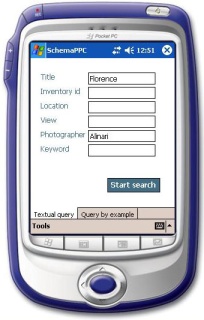 |
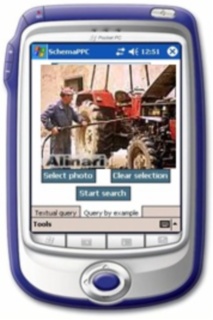 |
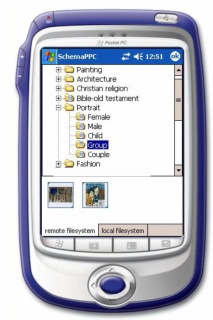 |
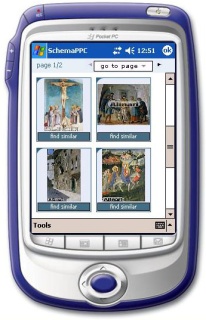 |
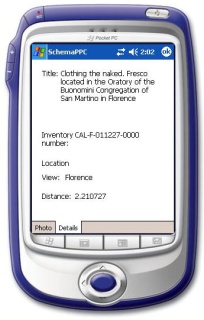 |
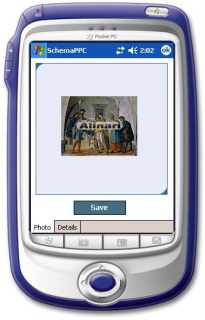 |
Alinari can allow the interaction to its database by means of XML standard: in particular
We can set up a methodology to send the query in xml and obtain xml results. This can help to have independent web interface development from the search tools by creating an intermediate layer that sends requests from remote servers other than Alinari’s.
Next we have put an example of what said: a CSP (Content Search Platform) is next described that uses Alinari’s contents (AP Alinari Platform) that will be described right after.
Back to D5.1orig System Specification

